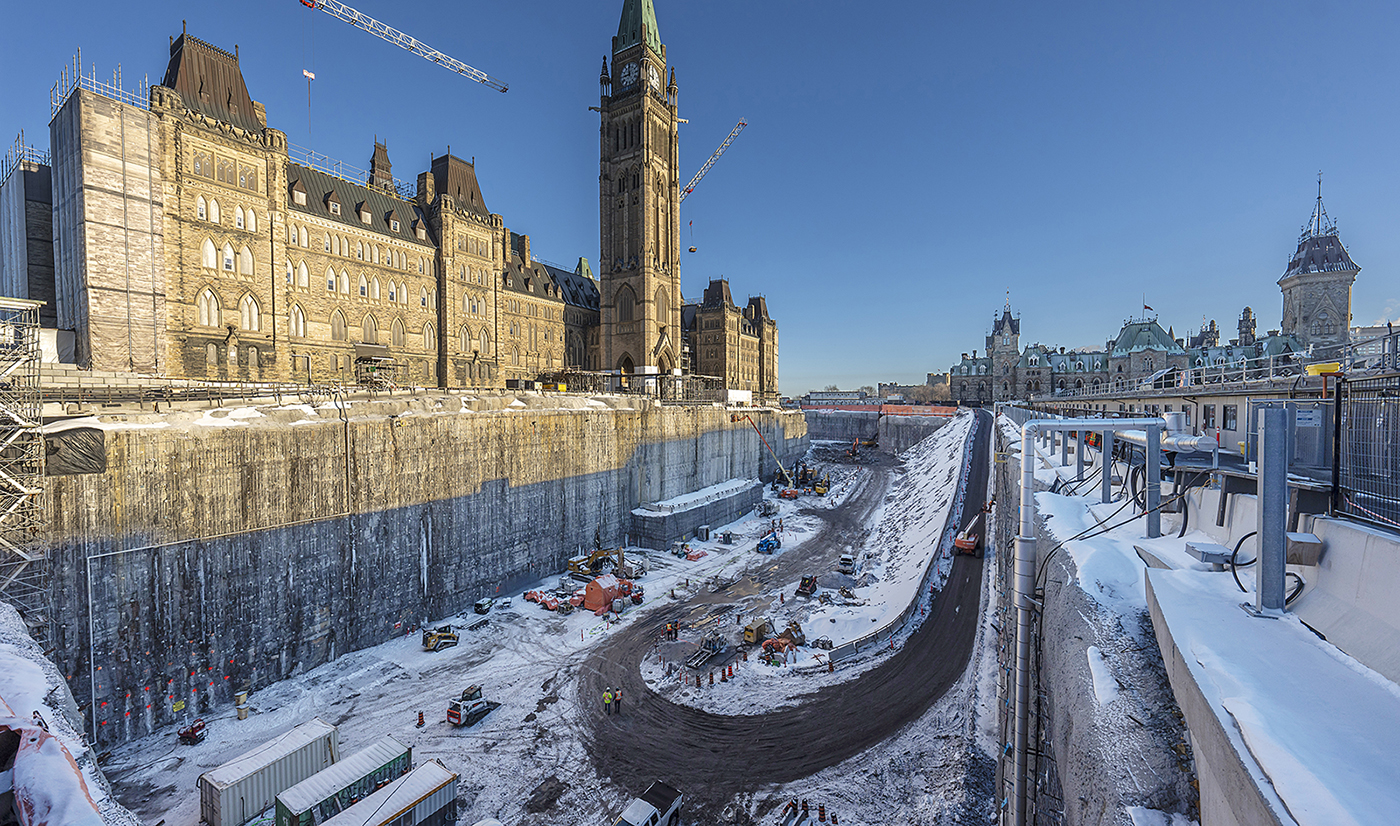Groundbreaking technology: Centre Block’s new green climate control

In February 2019, the Senate moved to the Senate of Canada Building, a former train station built in 1912. The Senate will occupy this temporary location while Parliament’s Centre Block — the Senate’s permanent home — is rehabilitated. Centre Block’s mechanical, electrical and heating systems will be upgraded and the 100-year-old building will be brought up to current fire, accessibility, security and seismic standards.
Although Centre Block is shuttered for rehabilitation work, Canadians can still experience its art and architecture — as well as the Senate of Canada Building’s — through the Senate’s immersive virtual tours.
If you’ve been following the work on Parliament Hill, you’ve noticed the gaping pit that has opened up in front of Centre Block. Half again as big as a football field and 23 metres deep, it will eventually contain the three-storey, 32,000-square-metre Parliament Welcome Centre — where an anticipated three million annual visitors will begin their tours of the Parliament buildings and where the mechanical systems that heat and cool the complex will be housed.
What you can’t see is what’s taking shape underneath: a geoexchange field one hectare in area honeycombed with 92 pipes extending 250 metres down into the bedrock, three times deeper than the height of Centre Block’s Peace Tower. This network of geoexchange boreholes holds the key to efficiently heating and cooling the new Centre Block — an area of nearly 93,000 square metres.

Set in stone
Geoexchange is not a new technology, but its scale is increasing. Across the country, universities, civic centres, apartment buildings —even entire neighbourhoods — are connecting to geoexchange fields. It’s a technology that promises to turn the bedrock under Parliament Hill into what is essentially a giant air conditioning and heating unit while transforming Centre Block from one of the least energy-efficient government buildings in the country to one that meets stringent net zero-carbon standards.
“We are using it as seasonal storage,” explained Martin Sing, Team Lead for Energy and Sustainability for CENTRUS, the consortium in charge of architectural and engineering design for the Centre Block rehabilitation project. “During the summertime, when we need to cool the building, we extract heat out of it. Rather than simply vent that heat, we’ll store it in the ground. During the wintertime, we can pull that heat out and use it to warm the building.”
For a hundred years, a nearby heating and cooling plant kept Centre Block comfortable for users. If a room was too cold, radiators kicked in and hot water drove the cold out. If it was too hot, cold water circulating through coils cooled the room. In parts of the building that lacked air conditioning, windows were simply left open. Hot and cold air were not treated as resources to be captured and reused but simply as waste to be expelled.
Geoexchange technology, by contrast, offers an economical, convenient way to store and reuse what used to be waste energy. It takes advantage of the fact that, at depths of 10 metres or more, bedrock maintains a constant temperature of 10 to 13°C year-round, unaffected by surface temperatures.
“Water flowing through the system in the wintertime will be colder than the bedrock, so it will suck the heat out of the bedrock and bring it into the building” Mr. Sing explained. “In the summertime, the water will be warmer than the bedrock, so it will lose that heat to the bedrock and store that heat energy for us.”
Closed-loop system
Within the geoexchange field, a network of boreholes perforates the bedrock. Each borehole contains a pair of polyethylene pipes — one going down and one coming back up — connected with a U-joint at the bottom and filled with a mixture of water and glycol that circulates between the building and the bedrock. The system forms a closed loop that channels waste heat from the building to where it can be stored in the bedrock and retrieved as needed.
“It’s similar to sub-floor heating, just at a bigger scale,” Mr. Sing said. “Instead of heating a floor you’re heating a big chunk of bedrock.”
Centre Block will be heated and cooled almost entirely with electricity, relying primarily on an industrial-scale heat pump. The heat pump will direct hot or cold water to the parts of the building that need it and redirect any surplus to the network of underground geoexchange pipes for storage.
Centre Block’s carbon-neutral future
Even with drilling nearing completion, years of work remain.
“Once the shell of the Parliament Welcome Centre starts to go up, we’ll lay out the branch piping to connect those boreholes back to central points in the building,” Mr. Sing said.
“As construction continues and equipment goes in, we’ll install the heat pump along with all the pipes and pumps that connect the entire system.”
With this geoexchange technology in place, Centre Block’s green future will be solidly grounded. A modernized, efficient Centre Block will demonstrate how heritage buildings can be made sustainable and even how the investment could save money over the long term.
“Any surplus heating energy that’s generated in the building, rather than throwing it away, we’re going to capture it, store it and reuse it,” Mr. Sing said.
“In the long run, it’s a more efficient and cost-effective way of doing things, and it helps us achieve carbon-neutral status.”






